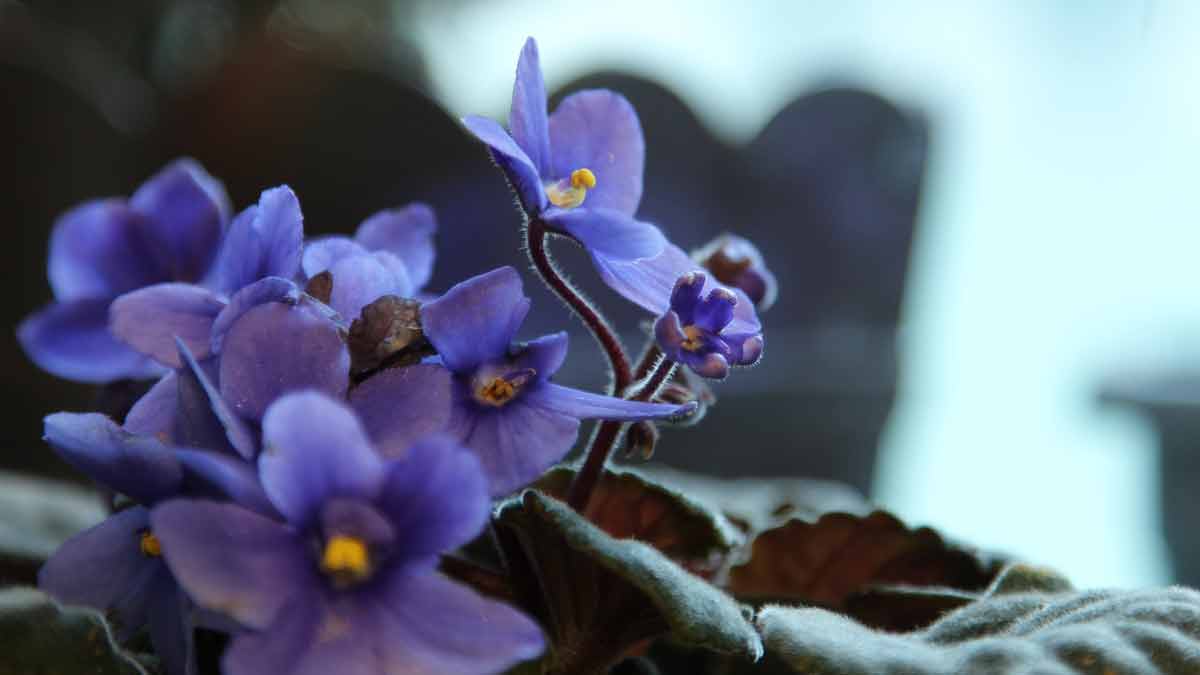African violet plants are popular houseplants because they are relatively easy to care for and bloom frequently.
However, even with the best care, sometimes their leaves will droop.
If you notice your African violet leaves drooping, don’t panic!
In most cases, it is a problem that can be easily fixed.
Why Are My African Violet Leaves Drooping?
There are a few reasons why your African violet leaves might be drooping.
Here are some of the most common causes:
1. Not Enough Water
One of the most common reasons African violet leaves droop is insufficient watering.
African violets need to be watered regularly, about once a week or when the soil feels dry.
If you don’t give your plant enough water, the leaves will lose moisture and start to droop.
How To Tell If Your African Violet Needs Water
There are a few ways to tell if your African violet is underwatered.
First, check the soil. If it feels dry, it’s time to water your plant.
Another way to tell is by looking at the leaves. If they are wilting or drooping, that’s a sign that the plant needs more water.
Other common signs of underwatering include:
- Leaves that are yellow or brown
- Leaves that are dry or crispy
- Stunted growth
How To Treat an Underwatered African Violet
If you think your African violet is underwatered, the best thing to do is to water it thoroughly.
Let the water run through the pot until it comes out of the drainage holes, then empty any excess water from the saucer.
Don’t water again until the soil is dry.
African violets need to be watered regularly, about once a week or when the soil feels dry.
2. Too Much Water
While not watering your African violet enough can cause droopy leaves, so can overwatering it.
If you water your plant more than it needs, the roots will start to rot, and the leaves will droop.
This is a common problem for African violets watered from the bottom up.
If the roots sit in water for too long, they will start to rot.
How To Tell If Your African Violet Is Overwatered
There are a few ways to tell if your African violet plant is overwatered.
First, check the soil. If it is soggy or wet, that’s a sign that the plant has been overwatered.
Another way to tell is by looking at the leaves. If they are wilting or yellowing, that’s a sign of overwatering.
Other common signs of overwatering include:
- Mushy or soft leaves
- Brown or yellow leaves
- Leaves falling off
- Mold or mildew on the leaves
- Black or brown spots on the leaves
How To Treat an Overwatered African Violet
If you think your African violet is overwatered, the best thing to do is to stop watering it for a while.
Let the soil dry out completely before watering again.
If the leaves are already wilting or yellow, you can try to rescue the plant by removing it from the pot and allowing the roots to dry out.
Once the roots are dry, you can replant the African violet in fresh, dry soil.
3. Low Humidity
African violets need high humidity to thrive.
They are native to tropical rainforests, so they are used to a lot of moisture in the air.
If the air in your home is too dry, it can cause the leaves of your African violet to droop.
How To Tell If Your African Violet Needs More Humidity
There are several ways to tell if your African violet needs more humidity.
First, check the leaves. If they are wilting or drooping, that’s a sign that the air is too dry.
Another way to tell is by looking at the flowers. If they are faded or drooping, that indicates low humidity.
Other common signs of low humidity include:
- Leaves that are dry or crispy
- Leaves that are brown or yellow
- Leaves that are falling off
- Buds that won’t open
- Dying flowers
How To Treat an African Violet with Low Humidity
If you think your African violet needs more humidity, you can do a few things.
First, try misting the leaves with water. This will help to raise the humidity around the plant.
Another option is to put the pot on a tray of pebbles and water. The evaporating water will help to raise the humidity around the plant.
You can also try using a humidifier. This will help to raise the humidity in the entire room, not just around the plant.
4. Heat Stress
African violets don’t like it when it’s too hot.
If the temperature gets too high, it can cause the leaves of your African violet to droop.
Although African violets are native to tropical rainforests, they don’t like the temperature to be too hot.
They prefer a temperature that is between 68 and 72 degrees Fahrenheit.
How To Tell If Your African Violet Is Stressed By Heat
There are a few ways to tell if your African violet is stressed by heat.
If the leaves are drooping and the soil is dry, it could be a sign that the temperature is too high.
Other signs of heat stress in African violets include:
- Leaves turning yellow
- Flowers fading in color
- Plant not blooming
How To Treat an African Violet That Is Stressed By Heat
If you think your African violet is stressed by heat, moving it to a cooler location is best.
A room that is between 68 and 72 degrees Fahrenheit is ideal.
Keep the plant out of direct sunlight, which can worsen the problem.
5. Transplant Shock
Transplant shock is a common problem for African violets.
It occurs when the plant is moved from one pot to another or repotted with new potting soil.
The plant’s roots are disturbed during this process, which can cause stress and lead to droopy leaves.
How To Tell If Your African Violet Is Experiencing Transplant Shock
There are several ways to tell if your African violet is experiencing transplant shock.
If the leaves are drooping and the stems are weak, this indicates that the plant is stressed.
Other signs of transplant shock include:
- Leaves turning yellow or brown
- Wilting leaves
- Curling leaves
- Buds falling off
How To Treat an African Violet That Is Experiencing Transplant Shock
If you think your African violet is experiencing transplant shock, you can do a few things to help it recover.
First, make sure that the plant is in the correct pot. The pot should be big enough for the roots to spread out but not too big.
Second, water the plant regularly. Keep the soil moist but not soggy.
Third, give the plant some time to adjust. It can take a few weeks for the plant to recover from transplant shock.
6. Root Rot
Root rot is a common problem for African violets.
It occurs when the plant roots sit in water for too long.
This can happen if the pot doesn’t have drainage holes or if the plant is watered too often.
Root rot can cause the leaves of your African violet to droop.
How To Tell If Your African Violet Has Root Rot
There are several ways to tell if your African violet has root rot.
If the leaves are drooping and the plant is wilting, this is a good indication that the roots are rotted.
Other signs of root rot include:
- Mushy or discolored roots
- Bad smell coming from the pot
- Leaves turning yellow or brown
- Black spots on the leaves
- Stunted growth
How To Treat an African Violet With Root Rot
If you think your African violet has root rot, the best thing to do is to repot the plant.
Remove the plant from its pot and check the roots.
Trim away any mushy or discolored roots.
Then, repot the plant in fresh potting mix.
Be sure to use a drainage hole pot to prevent the problem from happening again.
7. Pest Infestation
Pests can be a problem for African violets.
Aphids, mealybugs, and spider mites are all common pests that can infest your indoor plant.
Pests can cause several problems for your African violet, including droopy leaves.
How To Tell If Your African Violet Is Infested With Pests
There are several ways to tell if your African violet is infested with pests.
If the leaves are drooping and small insects on the plant, the plant has pests.
Other signs of a pest infestation include:
- White, cottony masses on the leaves (mealybugs)
- Small, black insects on the leaves (aphids)
- Webbing on the leaves (spider mites)
- Yellowing or browning of the leaves
How To Treat an African Violet That Is Infested With Pests
If you think your African violet is infested with pests, there are a few things you can do to eliminate them.
First, try to remove the pests by hand. Use a cotton swab dipped in rubbing alcohol to kill aphids and mealybugs.
Use a fine-mist sprayer to apply water to the leaves for spider mites. This will remove the spider mites and their webbing.
Second, use a natural pesticide to get rid of the pests.
Neem oil and insecticidal soap are effective against most common indoor plant pests.
Third, introduce beneficial insects to your home.
Ladybugs and green lacewings will eat aphids, mealybugs, and spider mites.
8. Not Enough Light
African violets need bright indirect light to thrive.
If your plant is not getting enough light, the leaves will start to droop.
How To Tell If Your African Violet Is Not Getting Enough Light
There are several ways to tell if your African violet is not getting enough light.
If the leaves are drooping and the plant is leaning towards the light source, this indicates that the plant needs more light.
Other signs of too little light include:
- Leaves that are pale or yellow
- Stunted growth
- Fewer flowers
How To Treat an African Violet That Is Not Getting Enough Light
If you think your African violet is not getting enough light, you can do a few things to help the plant.
Move the plant to a brighter location.
If possible, place the plant near a west- or east-facing window. This will provide the plant with bright indirect light.
You can also use grow lights to give your African violet the light it needs.
How To Prevent African Violet Leaves From Drooping
The best way to prevent African violet leaves from drooping is to provide the plant with the proper care.
Here are a few tips to help you care for your African violet:
- Water the plant when the soil is dry. Do not allow the soil to become soggy.
- Repot the plant every year in fresh potting mix.
- Use a well-drained pot with drainage holes.
- Provide the plant with bright indirect light. Avoid direct sunlight, which can scorch the leaves.
- Keep the temperature around the plant consistent. African violets prefer temperatures between 65 and 75 degrees Fahrenheit
- Trim away any dead or damaged leaves.
- Keep the plant away from drafts and air vents.
- Check the plant regularly for pests and treat them promptly if found.
These tips will help you keep your African violet healthy and prevent the leaves from drooping.
Final Thoughts
African violet leaf drooping is a common problem that several factors can cause.
By understanding the possible causes, you can take steps to correct the problem and keep your African violets healthy and thriving.
Check the soil moisture, light levels, and temperature if you notice your African violet leaves drooping.
These are all common causes of leaf drooping in African violets.
If the problem persists, check for pests or diseases.
These can also cause African violet leaves to droop.
With a little investigation, you should be able to identify the cause of your African violet leaf drooping and take steps to correct the problem.







